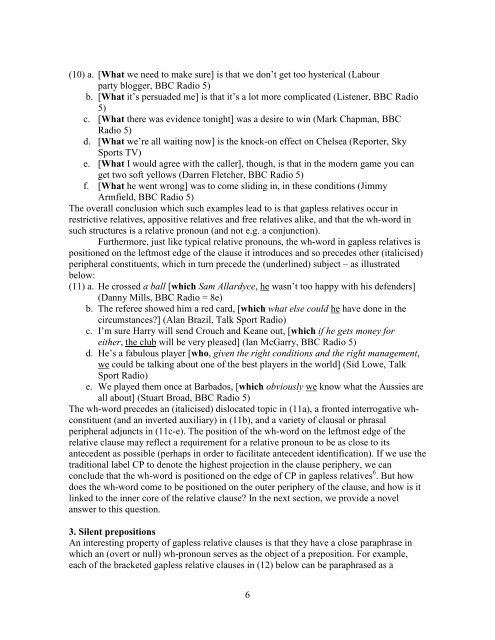1 GAPS, GHOSTS AND GAPLESS RELATIVES IN ... - ling.auf.net
1 GAPS, GHOSTS AND GAPLESS RELATIVES IN ... - ling.auf.net
1 GAPS, GHOSTS AND GAPLESS RELATIVES IN ... - ling.auf.net
You also want an ePaper? Increase the reach of your titles
YUMPU automatically turns print PDFs into web optimized ePapers that Google loves.
(10) a. [What we need to make sure] is that we don’t get too hysterical (Labour<br />
party blogger, BBC Radio 5)<br />
b. [What it’s persuaded me] is that it’s a lot more complicated (Listener, BBC Radio<br />
5)<br />
c. [What there was evidence tonight] was a desire to win (Mark Chapman, BBC<br />
Radio 5)<br />
d. [What we’re all waiting now] is the knock-on effect on Chelsea (Reporter, Sky<br />
Sports TV)<br />
e. [What I would agree with the caller], though, is that in the modern game you can<br />
get two soft yellows (Darren Fletcher, BBC Radio 5)<br />
f. [What he went wrong] was to come sliding in, in these conditions (Jimmy<br />
Armfield, BBC Radio 5)<br />
The overall conclusion which such examples lead to is that gapless relatives occur in<br />
restrictive relatives, appositive relatives and free relatives alike, and that the wh-word in<br />
such structures is a relative pronoun (and not e.g. a conjunction).<br />
Furthermore, just like typical relative pronouns, the wh-word in gapless relatives is<br />
positioned on the leftmost edge of the clause it introduces and so precedes other (italicised)<br />
peripheral constituents, which in turn precede the (underlined) subject – as illustrated<br />
below:<br />
(11) a. He crossed a ball [which Sam Allardyce, he wasn’t too happy with his defenders]<br />
(Danny Mills, BBC Radio = 8e)<br />
b. The referee showed him a red card, [which what else could he have done in the<br />
circumstances?] (Alan Brazil, Talk Sport Radio)<br />
c. I’m sure Harry will send Crouch and Keane out, [which if he gets money for<br />
either, the club will be very pleased] (Ian McGarry, BBC Radio 5)<br />
d. He’s a fabulous player [who, given the right conditions and the right management,<br />
we could be talking about one of the best players in the world] (Sid Lowe, Talk<br />
Sport Radio)<br />
e. We played them once at Barbados, [which obviously we know what the Aussies are<br />
all about] (Stuart Broad, BBC Radio 5)<br />
The wh-word precedes an (italicised) dislocated topic in (11a), a fronted interrogative whconstituent<br />
(and an inverted auxiliary) in (11b), and a variety of clausal or phrasal<br />
peripheral adjuncts in (11c-e). The position of the wh-word on the leftmost edge of the<br />
relative clause may reflect a requirement for a relative pronoun to be as close to its<br />
antecedent as possible (perhaps in order to facilitate antecedent identification). If we use the<br />
traditional label CP to denote the highest projection in the clause periphery, we can<br />
conclude that the wh-word is positioned on the edge of CP in gapless relatives 6 . But how<br />
does the wh-word come to be positioned on the outer periphery of the clause, and how is it<br />
linked to the inner core of the relative clause? In the next section, we provide a novel<br />
answer to this question.<br />
3. Silent prepositions<br />
An interesting property of gapless relative clauses is that they have a close paraphrase in<br />
which an (overt or null) wh-pronoun serves as the object of a preposition. For example,<br />
each of the bracketed gapless relative clauses in (12) below can be paraphrased as a<br />
6
















